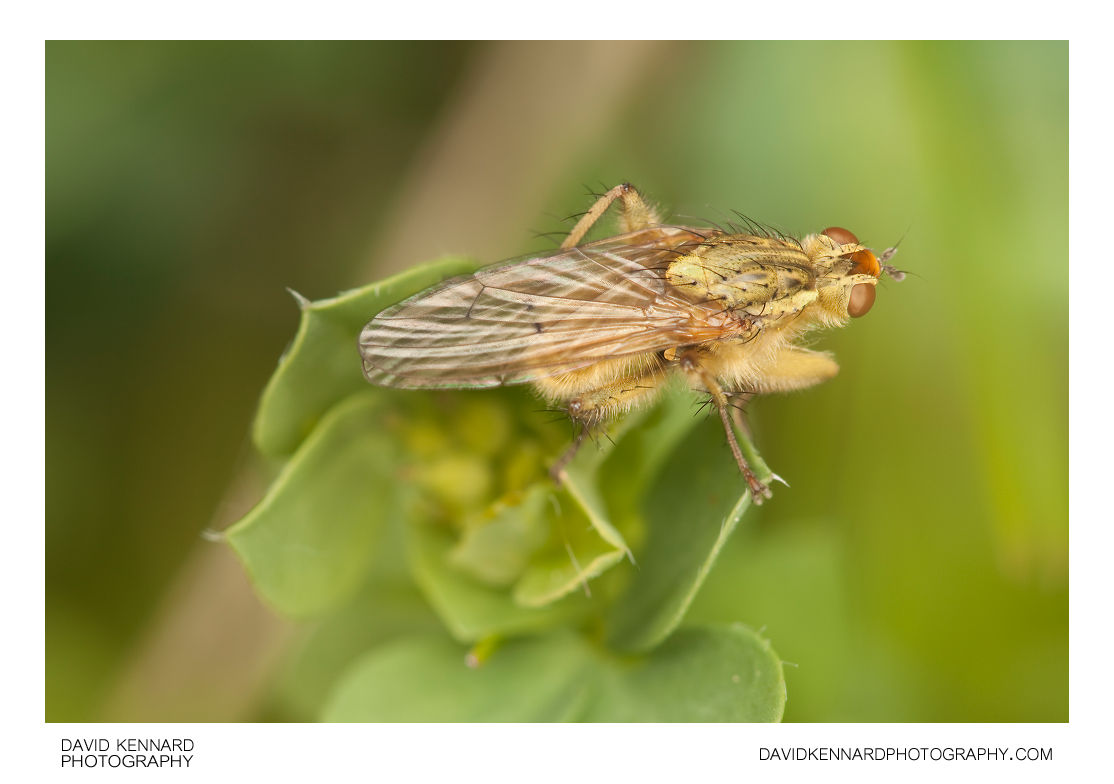Common yellow dung fly (Scathophaga stercoraria)

Description
- Title:
- Common yellow dung fly (Scathophaga stercoraria)
- Caption / Description:
-
Scathophaga stercoraria, known as the common yellow dung fly or sometimes called the golden dung fly. It is one of the most familiar and abundant of flies in many parts of the northern hemisphere. As its common name suggests, it is often found on mammal faeces, most notably that of horses and cows.
From 5 mm to 11 mm in length. The adult males of Scathophaga stercoraria are bright golden-yellow with orange-yellow fur on the front legs. Females are a little duller in colour, with pronounced green-brown tinges, and lacking the bright coloured fur on the fore legs. It is a very variable species, and part of this may be climate driven.
The adults are mostly predators on smaller insects — mostly other Diptera, they will also feed on pollen, but most specimens seen on flowers will be hunting prey there. Both males and females are found on dung, the males only feeding on other insects that visit dung, such as blow-flies. Females will be there both to feed and oviposit on the dung surface.
Females prefer to lay their eggs on the small hills of the dung surface and avoid depressions and pointed parts of the dung. This ensures survival, as emergence is better by avoiding the drying on small points in the dung. Also by avoiding possible drowning by rain by not laying eggs in depressions of the dung surface. The female yellow dung-fly is capable of making these decisions about her egg placement, and thus increasing possibility of success of her future generations. The eggs hatch into predatory larvae and feed on insect larvae within the dung. After 21 days or more of feeding, dependent on conditions, the larvae burrow into the soil around and beneath the dung and then develop into pupae, before developing into adult flies.
Scathophaga stercoraria can produce four or five generations per season. The adults are active throughout much of the year in most moderate climates. In most cases both males and females will mate multiple times, as is very common in insects. Much has been studied about the competition between genders and what factors determine mating success, and what part that in turn may play on the competitive nature on the larvae.
Description taken from Wikipedia: http://en.wikipedia.org/wiki/Scathophaga_stercoraria
- Tags / Keywords:
-
- Biota
- Life
- Vitae
- Eukaryota
- Animalia
- Animals
- Arthropoda
- Arthropods
- Insecta
- Insects
- Diptera
- Flies
- Scathophagidae
- Dung flies
- Scathophaga
- Scathophaga stercoraria
- Common yellow dung fly
- Golden dung fly
Admin
- Date Original Photo Taken:
- Original File Name:
- _MG_0095-6.psd
- Event:
- Rating:
- ☆
- Date this image added/last updated on website:
- Original File Dimensions:
- 4272px x 2848px
- File Type:
- JPEG
- Color Mode:
- RGB
- Original Image Color Profile:
- Adobe RGB (1998)
Location
- Location Created:
-
- Sublocation:
- City:
- Market Harborough
- Province/State:
- Leicestershire
- Country:
- United Kingdom
- World Region:
- Europe
- Geo-location:
- 52.474832485908, -0.94873461441944 View on map
Rights
- Copyright Status:
- Copyrighted
- Licensing Status:
- Rights Managed
- Available for Editorial Use:
- Yes
- Available for Commercial Use:
- Yes
- Copyright Notice:
- © 2010 Dave Kennard
Camera Data
- Date Digital Resource was created:
- Shutter speed:
- 1⁄200 s
- Aperture:
- f/8
- Camera Model:
- Canon EOS 450D
- ISO:
- 100
- Exposure Compensation:
- 0
- Focal Length:
- 100mm
- Focal Length (35mm equiv.):
- Metering Mode:
- Multi-segment
- Flash:
- On, Fired
- Exposure Mode:
- Manual
- White Balance:
- Manual
- Light Source:
- Exposure Program:
- Manual
Additional shooting metadata
- Lens:
- Canon EF 100mm F2.8 Macro USM
- Filters used:
- Additional Optics used:
- Setup:
- Handheld, 2 shots
Canon MT-24EX Macro Twin flash with home-made 'light tent' diffuser
Post Processing
- Image Modified:
- Software used:
-
- Adobe Photoshop CS4
- Adobe Camera RAW
- Post Processing:
Images combined for focus in PS CS4
Image expanded slightly to the top and right in PS CS4
